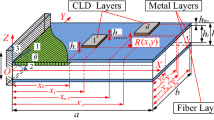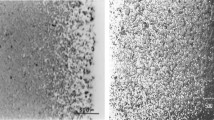Abstract
In this paper, in order to investigate the residual strain relief in the fatigued copper film with a thickness of 33 urn, an unconstraint vibration treatment process was simulated by finite element (FE) method. The experimental processes, including fatigue and unconstraint vibration processes, were simulated. The fatigue process for the original specimen and the vibration process for the damaged specimen were analyzed by the static and transient dynamic analysis, respectively. The simulation results showed that the unconstraint vibration treatment can lead to the residual strain of the fatigued copper film to be reduced and redistributed. The effect of the vibration parameters on the treatment effectiveness was analyzed by the different fatigue experiments and unconstraint vibration treatments, and the results showed that the FE simulation results are in agreement with the experimental observations.
Similar content being viewed by others
References
M. D. Sangid, The physics of fatigue crack initiation, International Journal of Fatigue, 57 (2013) 58–72.
X. Hu, X. Jia, Z. Bao, and Y. Song, Effect of notch geometry on the fatigue strength and critical distance of TC4 titanium alloy, Journal of Mechanical Science and Technology, 31 (10) (2017) 4727–4737.
J. S. Wang, C. C. Hsieh, C. M. Lin, E. C. Chen, C. W. Kuo, and W. Wu, The effect of residual stress relaxation by the vibratory stress relief technique on the textures of grains in AA 6061 aluminium alloy, Materials Science and Engineering A, 605 (2013) 98–107.
J. S. Wang, C. C. Hsieh, C. M. Lin, C. W. Kuo, and W. Wu, Texture evolution and residual stress relaxation in a cold-rolled Al-Mg-Si-Cu alloy using vibratory stress relief technique, Mefall. Mater Trans., 44 (2013) 806–818.
J. S. Wang, C. C. Hsieh, H. H. Lai, C. W. Kuo, P. T. Y. Wu, and W. Wu, The relationships between residual stress relaxation and texture development in AZ31 Mg alloys via the vibratory stress relief technique, Materials Characterization, 99(2015) 248–253.
D. Rao, D. Wang, L. Chen, and C. Ni, The effectiveness evaluation of 314L stainless steel vibratory stress relief by dynamic stress, International Journal of Fatigue, 29 (2007) 192–196.
C. Cancellieri, F. Moszner, M. Chiodi, S. Yoon, J. Janczak-Rusch and L. P. H. Jeurgens, The effect of thermal treatment on the stress state and evolving microstructure of Cu/W nano-multilayers, Journal of Applied Physics, 120 (2016) 1–10.
C. M. Sonsion, F. Muller, and A. Gresnigt, Influence of stress relieving by vibration on the fatigue behavior of welded joints in comparison to post-weld heat treatment, Fatigue and Fracture of Engineering Materials and Structures, 19 (1997)703–708.
R. Dawson, and D. G. Moffat, Vibratory stress relief: A fundamental study of its effectiveness, Journal of Engineering Materials and Technology, 102 (1980) 169–176.
A. S. M. Y. Munsi, A. J. Waddell, and C. A. Walker, The influence of vibratory treatment on the fatigue life of welds: A comparison with thermal stress relief, Strain, 37 (4) (2001) 141–149.
D. L. Rao, Z. Q. Zhu, L. G. Chen, and C. Ni, Reduce the residual stress of welded structures by post-weld vibration, Materials Science Forum, 27 (2005) 102–106.
Y. P. Lu, Z. Y. Ma, Q. S. Jia, and R. R. Gu, Research on vibratory stress relief mechanism, Mechanical Science and Technology, 20 (2001) 587–589.
J. Song, and Y. D. Zhang, Effect of vibratory stress relief on fatigue life of aluminium alloy 7075-T651, Advances in Mechanical Engineering, 8 (2016) 1–9.
H. J. Gao, Y. D. Zhang, Q. Wu, and J. Song, Experimental investigation on the fatigue life of Ti-6A1-4V treated by vibratory stress relief, Metals, 7 (2017) 158–170.
H. Gao, Y. Zhang, Q. Wu, J. Song, and K. Wen, Fatigue life of 7075-T651 aluminium alloy treated with vibratory stress relief, International Journal of Fatigue, 108 (2018) 62–67.
M. J. Vardanjani, M. Ghayour, and R. M. Homami, Analysis of the vibrational stress relief for reducing the residual stresses caused by machining, Experimental Techniques, 40 (2016)705–713.
S. Kwofie, Plastic model for simulation, description and evaluation of vibratory stress relief, Materials Science and Engineering: A, 516 (2009) 154–161.
D. Djuric, R. Valiant, K. Kerschbaumer, and N. Enzinger, Vibration stress relief treatment of welded high-strength martensitic steel, Welding in the World, 55 (2011) 86–93.
J. H. Lee, J. S. Kim, S. U. Kang, M. Hirohata, and K. H. Chang, Fatigue life analysis of steel tube member with T-shaped welded joint by FEM, International Journal of Steel Structures, 17 (2017) 833–841.
S. Li, H. Fang, X. Liu, W. Wang, Q. Wang, and W. Cm, A combined computational and experimental study on vibration stress relief for large welded DH36 steel tube, Journal ofVibroengineering, 18 (2016) 1486–1496.
M. M. El-Sayed, A. Y. Shash, and M. Abd-Rabou, Finite element modeling of aluminum alloy AA5083-O friction stir welding process, Journal of Materials Processing Technology, 252 (2018) 13–24.
H. S. Lim, and J. Yoo, FEM based simulation of the pulsed laser ablation process in nanosecond fields, Journal of Mechanical Science and Technology, 25 (7) (2011) 1811–1816.
C. Ni, L. Hua, X. Wang, Z. Wang, and Z. Ma, Numerical and experimental method for the prediction of the propagation life of fatigue crack on metallic materials, Journal of Mechanical Science and Technology, 32 (9) (2018) 4183–4190.
Q. Xiao, J. Zheng, J. Liu, and J. Fang, Analysis of the wheel/rail rolling contact fatigue of a high-speed train under the transient mechanism, Journal of Mechanical Science and Technology, 31 (5) (2017) 2235–2242.
M. J. Han, C. H. Lee, T. W. Park, and S. P. Lee, Low and high cycle fatigue of automotive brake discs using coupled thermo-mechanical finite element analysis under thermal loading, Journal of Mechanical Science and Technology, 32 (12) (2018) 5777–5784.
K. Lee, M. Song, and J. Seo, Finite element modeling and fatigue analysis of hypoid gears installed in a power transfer unit with a correlational study based on an experimental investigation, Journal of Mechanical Science and Technology, 33 (6) (2019) 2797–2807.
X. C. Zhao, Y. D. Zhang, H. W. Zhang, and Q. Wu, Simulation of vibration stress relief after welding based on FEM, Acta Metallurgica Sinica (English letters), 21 (2008) 289–294.
A. Sert, S. Gurgen, O. N. Çelik, and M. C. Kuşhan, Effect of heat treatment on the bending behavior of aluminum alloy tubes, Journal of Mechanical Science and Technology, 31 (11) (2017) 5273–5278.
B. Soheil, Z. Mirco, and G. Ugo, Fatigue degradation strategies to simulate crack propagation using peridynamic based computational methods, Latin American Journal of Solids and Structures, 16 (2019) 1–31.
R. Jiang, F. Pierron, S. Octaviani, and P. A. S. Reed, Characterisation of strain localisation processes during fatigue crack initiation and early crack propagation by SEM-DIC in an advanced disc alloy, Materials Science and Engineering: A, 699 (2017) 128–144.
Acknowledgments
This work was supported by the financial support of the National Natural Science Foundation of China (No. 51535001, 11572008).
Author information
Authors and Affiliations
Corresponding author
Additional information
Recommended by Associate Editor Heung Soo Kim
Hai-Meng Zhang received his M.S. engineering degree in College of Mechanical Engineering and Applied Electronics Technology from Beijing University of Technology in China, in 2016. At present, he is a Ph.D. student at the College of Mechanical Engineering and Applied Electronics Technology of Beijing University of Technology in China. His research interests include fatigue damage healing and finite element method.
De-Guang Shang is currently a Professor at the College of Mechanical Engineering and Applied Electronics Technology at Beijing University of Technology in China. He received his Ph.D. from Northeastern University, China, in 1997. His main areas of research interest are fatigue, fracture, and durability of structures.
Rights and permissions
About this article
Cite this article
Zhang, HM., Shang, DG., Lv, S. et al. Finite element simulation of unconstraint vibration treatment for fatigued copper film. J Mech Sci Technol 33, 4345–4352 (2019). https://doi.org/10.1007/s12206-019-0830-z
Received:
Revised:
Accepted:
Published:
Issue Date:
DOI: https://doi.org/10.1007/s12206-019-0830-z




